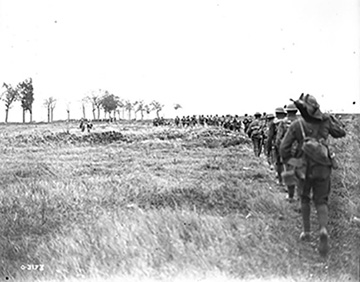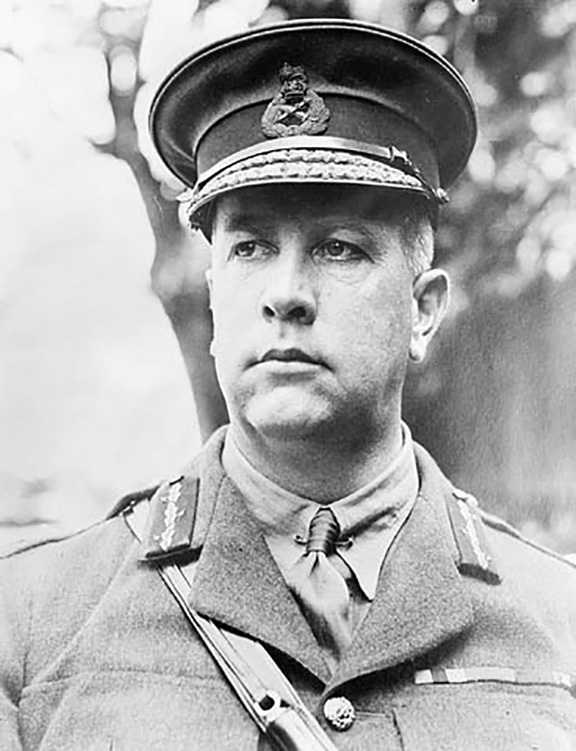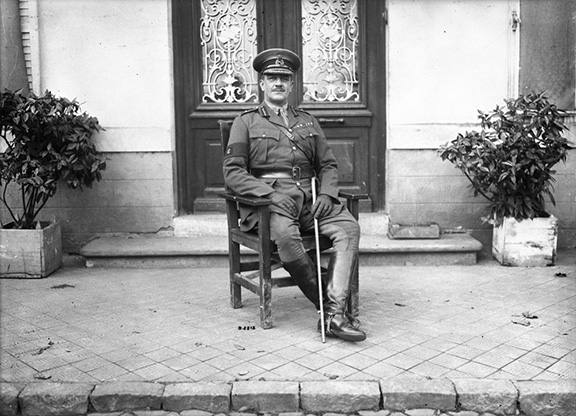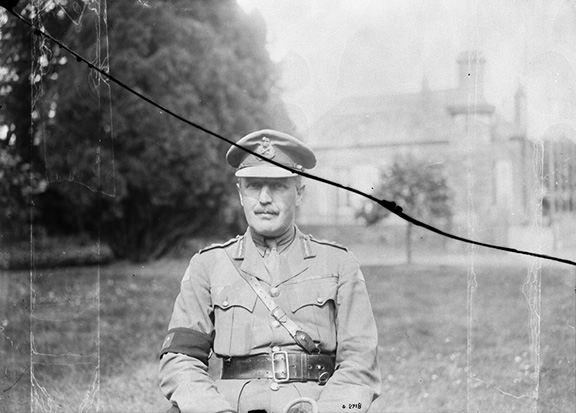Arras, 1918

Canadians advancing through a German barrage. Advance East of Arras. September, 1918.
Credit: Canada. Department of National Defence/Library and Archives Canada (MIKAN no. 3522265)
First World War
This battle honour designation refers to two battles of Arras in 1918:
Date
- 28 March 1918
- 26 August – 3 September 1918
Geographical parameters
- Road Authuille – Bertrancourt – Couin – Gaudiempré – Arras – Oppy
- No geographical parameters defined.
Context
- A battle honour formally entitled “First Battle of Arras, 1918” and itself being part of “The First Battles of the Somme, 1918”
- A group honour incorporating the “Battle of the Scarpe, 1918” and the “Battle of the Drocourt-Quéant Line”, formally entitled “The Second Battles of Arras, 1918”, and itself being part of “The Breaking of the Hindenburg Line (26 August – 12 October, 1918)”Footnote 1
Description
- The German Spring Offensive's main effort was an attack in the Picardy and Somme regions against the British Fifth Army. Although the Canadian Corps (Lieutenant-General Sir A.W. Currie), in the First Army sector was spared from the initial attack several Canadian cavalry and machine gun regiments did see action. Their roles were to assist in preventing a German breakthrough. Both the cavalry and motor machine gun batteries could be moved quickly to fill in gaps as required or to cover the withdrawal of infantry.
- The first part of this offensive saw the Canadian 2nd and 3rd Divisions (Major-General Sir H.E. Burstall and Major-General L.J. Lipsett) take part in an assault to the east of Arras astride the Arras-Cambrai road. In the first three days of fighting over what was difficult terrain with well-prepared German defences, the two Canadian divisions advanced over five miles and had seized the German Fresnes-Rouvroy defence system by the 28th of August. With this position securely in Canadian hands the Canadian Corps began planning for the next phase the assault on the Drocourt-Quéant Line. In order to prepare the assault on this formidable position, the artillery conducted wire cutting barrages; the engineers prepared bridges to cross the Canal du Nord and a number of minor operations were conducted to improve the jumping-off lines. There were also huge efforts required behind the line to repair and extend roads as well as to extend the light rail lines in order to move much needed supplies. The attack on this formidable German defensive position began on 2 September. Most of the Canadian objectives were taken on that day and most importantly the Drocourt-Quéant line had been overrun on a width of about 1600 metres. Canadian orders at the end of 2 September were to continue to press the offensive on the 3rd but the Germans withdrew during the night to positions east of the Canal du Nord. This second phase had seen the Canadian Corps advance an additional five miles and to capture all German positions west of the Canal du Nord. Between 26 August and 4 September the Canadian Corps had advanced over ten miles and captured one of the most heavily fortified German defensive positions on the Western Front.

Lieutenant General Currie, Commander of the Canadian Corps in France, and A.D.C. Location unknown. June, 1917.
Credit: Canada. Department of National Defence/Library and Archives Canada/PA-001370; (MIKAN no. 3191901)

This photograph shows a Mk. V female tank advancing across a sunken roadway on the Arras front. Advance East of Arras. September, 1918.
Credit: Canada. Department of National Defence/Library and Archives Canada (MIKAN no. 3522274)

Major-General Sir Henry Edward Burstall was General Officer Commanding the 2nd Canadian Division. Location unknown. December, 1917.
Credit: Canada. Department of National Defence/Library and Archives Canada (MIKAN no. 3213482)

Major-General L.J. Lipsett, commander of the 3rd Canadian Division. Camblain l'Abbé. May, 1918.
Credit: Canada. Department of National Defence/Library and Archives Canada; (MIKAN no. 3218379)
Awarded to:
Currently serving units
- 1st Hussars
Award to the 1st Hussars (GO 71/30) - 10th Field Artillery Regiment, RCA
Award to The Assiniboia Regiment (GO 71/30) - 26th Field Artillery Regiment, RCA
Award to The Manitoba Rangers (GO 71/30) - 42nd Field Artillery Regiment (Lanark and Renfrew Scottish), RCA
Award to The Lanark and Renfrew Scottish Regiment (GO 71/30) - 48th Highlanders of Canada
Awards to the 15th Canadian Infantry Battalion, CEF (GO 110/29) and The 48th Regiment (Highlanders) (GO 110/29) - 49th Field Artillery Regiment, RCA
Award to The Sault Ste. Marie Regiment (GO 71/30) - 56th Field Artillery Regiment, RCA
Awards to the 4th Canadian Infantry Battalion, CEF (GO 110/29) and The Dufferin Rifles of Canada (GO 110/29) - 64th Field Battery, RCA
Award to The Yorkton Regiment (GO 71/30) - 116th Independent Field Battery, RCA
Award to The Kenora Light Infantry (GO 71/30) - The Argyll and Sutherland Highlanders of Canada (Princess Louise's)
Awards to the 19th Canadian Infantry Battalion, CEF (GO 110/29), the 3rd Battalion, Canadian Machine Gun Corps, CEF (GO 123/29), The Argyll and Sutherland Highlanders of Canada (Princess Louise's) (GO 110/29), and the 3rd Machine Gun Battalion, CMGC (GO 123/29) - The Black Watch (Royal Highland Regiment) of Canada
Awards to the 13th Canadian Infantry Battalion, CEF (GO 110/29), the 42nd Canadian Infantry Battalion, CEF (GO 110/29), and The Royal Highlanders of Canada (GO 110/29) - The British Columbia Dragoons
Awards to the 2nd Canadian Mounted Rifles Battalion, CEF (GO 110/29) and The British Columbia Dragoons (GO 110/29) - The British Columbia Regiment (Duke of Connaught's Own)
Awards to the 7th Canadian Infantry Battalion, CEF (GO 71/30), the 29th Canadian Infantry Battalion, CEF (GO 123/29), the 102nd Canadian Infantry Battalion, CEF (GO 110/29), the 1st British Columbia Regiment (Duke of Connaught's Own) (GO 110/29), The North British Columbia Regiment (GO 123/29), The Irish Fusiliers of Canada (GO 71/30), and The Vancouver Regiment (GO 71/30) - The Brockville Rifles
Award to The Brockville Rifles (GO 71/30) - The Calgary Highlanders
Awards to the 10th Canadian Infantry Battalion, CEF (GO 123/29) and The Calgary Highlanders (GO 110/29) - The Cameron Highlanders of Ottawa
Awards to the 38th Canadian Infantry Battalion, CEF (GO 123/29) and The Ottawa Highlanders (GO 110/29) - The Canadian Grenadier Guards
Awards to the 87th Canadian Infantry Battalion, CEF (GO 110/29) and The Canadian Grenadier Guards (GO 110/29) - The Canadian Scottish Regiment (Princess Mary's)
Awards to the 16th Canadian Infantry Battalion, CEF (GO 110/29) and The Canadian Scottish Regiment (GO 110/29) - The Cape Breton Highlanders
Awards to the 85th Canadian Infantry Battalion, CEF (GO 110/29) and The Cape Breton Highlanders (GO 110/29) - The Essex and Kent Scottish
Awards to the 18th Canadian Infantry Battalion, CEF (GO 110/29) and The Essex Scottish (GO 110/29) - The Fort Garry Horse
Award to The Manitoba Horse (GO 88/31) - Les Fusiliers Mont-Royal
Award to Les Carabiniers Mont-Royal (GO 71/30) - Governor General's Foot Guards
Awards to the 2nd Canadian Infantry Battalion, CEF (GO 123/29) and The Governor General's Foot Guards (GO 71/30 and GO 32/32) - The Governor General's Horse Guards
Awards to the 4th Canadian Mounted Rifles Battalion, CEF (GO 110/29), The Governor General's Body Guard (GO 112/35), and The Mississauga Horse (GO 110/29) - The Grey and Simcoe Foresters
Awards to The Grey Regiment (GO 71/30) and The Simcoe Foresters (GO 71/30) - The Halifax Rifles (RCAC)
Award to The Halifax Rifles (GO 71/30) - The Hastings and Prince Edward Regiment
Awards to The Argyll Light Infantry (GO 71/30) and The Northumberland Regiment (GO 71/30) - Irish Regiment of Canada
Awards to the 1st Battalion, Canadian Machine Gun Corps, CEF (GO 123/29), the 1st Machine Gun Battalion, CMGC (GO 123/29), and The Irish Regiment (GO 71/30) - The King's Own Calgary Regiment (RCAC)
Awards to the 50th Canadian Infantry Battalion, CEF (GO 110/29) and The Calgary Regiment (GO 110/29) - The Lake Superior Scottish Regiment
Awards to the 52nd Canadian Infantry Battalion, CEF (GO 123/29) and The Lake Superior Regiment (GO 110/29) - The Lincoln and Welland Regiment
Award to The Lincoln Regiment (GO 71/30) - The Lorne Scots (Peel, Dufferin and Halton Regiment)
Awards to The Halton Rifles (GO 71/30) and The Peel and Dufferin Regiment (GO 71/30) - The Loyal Edmonton Regiment (4th Battalion, Princess Patricia's Canadian Light Infantry)
Awards to the 49th Canadian Infantry Battalion, CEF (GO 110/29) and The Edmonton Regiment (GO 110/29) - The North Saskatchewan Regiment
Awards to the 1st Canadian Mounted Rifles Battalion, CEF (GO 110/29), the 5th Canadian Infantry Battalion, CEF (GO 110/29), the 16th Canadian Light Horse (GO 110/29), The Saskatchewan Mounted Rifles (GO 110/29), The Saskatoon Light Infantry (GO 110/29), The Battleford Light Infantry (GO 71/30), and The Prince Albert Volunteers (GO 71/30) - The North Shore (New Brunswick) Regiment
Award to The North Shore (New Brunswick) Regiment (GO 71/30) - The Nova Scotia Highlanders
Awards to the 25th Canadian Infantry Battalion, CEF (GO 123/29), The Colchester and Hants Regiment (GO 110/29), and The Cumberland Highlanders (GO 71/30) - The Ontario Regiment (RCAC)
Awards to the 116th Canadian Infantry Battalion, CEF (GO 110/29) and The Ontario Regiment (GO 123/29) - The Prince Edward Island Regiment (RCAC)
Awards to The Prince Edward Island Light Horse (GO 71/30) and The Prince Edward Island Highlanders (GO 71/30)) - The Princess of Wales' Own Regiment
Awards to the 21st Canadian Infantry Battalion, CEF (GO 123/29) and The Princess of Wales' Own Regiment (GO 110/29) - Princess Patricia's Canadian Light Infantry
Award to Princess Patricia's Canadian Light Infantry (GO 123/29) - The Queen's Own Cameron Highlanders of Canada
Awards to the 43rd Canadian Infantry Battalion, CEF (GO 110/29) and The Queen's Own Cameron Highlanders of Canada (GO 110/29)) - The Queen's Own Rifles of Canada
Awards to the 3rd Canadian Infantry Battalion, CEF (GO 123/29) and The Queen's Own Rifles of Canada (GO 110/29) - The Queen's York Rangers (1st American Regiment) (RCAC)
Awards to the 20th Canadian Infantry Battalion, CEF (GO 110/29), The Queen's Rangers, 1st American Regiment (GO 110/29), and The York Rangers (GO 71/30) - The Rocky Mountain Rangers
Award to The Rocky Mountain Rangers (GO 71/30) - Royal 22e Régiment
Award to the Royal 22e Régiment (GO 110/29) - The Royal Canadian Hussars (Montreal)
Awards to the 1st Canadian Motor Machine Gun Brigade, CEF (GO 110/29) and the 1st Motor Machine Gun Brigade (GO 110/29) - The Royal Canadian Regiment
Awards to the 1st Canadian Infantry Battalion, CEF (GO 110/29), the 2nd Battalion, Canadian Machine Gun Corps, CEF (GO 123/29), The Royal Canadian Regiment (GO 110/29), The Canadian Fusiliers (City of London Regiment) (GO 110/29), the 2nd Machine Gun Battalion, CMGC (GO 123/29), and The Oxford Rifles (GO 71/30) - The Royal Hamilton Light Infantry (Wentworth Regiment)
Awards to the 4th Canadian Infantry Battalion, CEF (GO 110/29) and The Royal Hamilton Light Infantry (GO 110/29) - The Royal Highland Fusiliers of Canada
Award to The Highland Light Infantry of Canada (GO 71/30) - The Royal Montreal Regiment
Awards to the 14th Canadian Infantry Battalion, CEF (GO 110/29) and The Royal Montreal Regiment (GO 110/29) - The Royal New Brunswick Regiment
Awards to the 26th Canadian Infantry Battalion, CEF (GO 110/29), The Carleton Light Infantry (GO 110/29), The Saint John Fusiliers (GO 110/29), The York Regiment (GO 71/30), and The New Brunswick Rangers (GO 71/30) - The Royal Regiment of Canada
Awards to the 3rd Canadian Infantry Battalion, CEF (GO 123/29), the 58th Canadian Infantry Battalion, CEF (GO 110/29), and The Toronto Regiment (GO 110/29) - The Royal Regina Rifles
Awards to the 28th Canadian Infantry Battalion, CEF (GO 110/29) and The Regina Rifle Regiment (GO 110/29) - The Royal Westminster Regiment
Awards to the 47th Canadian Infantry Battalion, CEF (GO 110/29) and The Westminster Regiment (GO 110/29) - The Royal Winnipeg Rifles
Awards to the 8th Canadian Infantry Battalion, CEF (GO 110/29), the 10th Canadian Infantry Battalion, CEF (GO 123/29), the 27th Canadian Infantry Battalion, CEF (GO 123/29), the 44th Canadian Infantry Battalion, CEF (GO 110/29), The Winnipeg Rifles (GO 110/29), and The Winnipeg Light Infantry (GO 110/29) - The Saskatchewan Dragoons
Awards to the 46th Canadian Infantry Battalion, CEF (GO 110/29) and The King's Own Rifles of Canada (GO 110/29) - The Seaforth Highlanders of Canada
Awards to the 72nd Canadian Infantry Battalion, CEF (GO 5/31) and The Seaforth Highlanders of Canada (GO 5/31) - The Sherbrooke Hussars
Awards to the 5th Canadian Mounted Rifles Battalion, CEF (GO 110/29), The Sherbrooke Regiment (GO 71/30), and the 7th/11th Hussars (GO 10/39) - The South Alberta Light Horse
Awards to the 31st Canadian Infantry Battalion, CEF (GO 110/29), The South Alberta Regiment (GO 110/29), the 19th Alberta Dragoons (GO 71/30), and The Edmonton Fusiliers (GO 71/30) - Stormont, Dundas and Glengarry Highlanders
Award to The Stormont, Dundas and Glengarry Highlanders (GO 71/30) - The Toronto Scottish Regiment (Queen Elizabeth The Queen Mother's Own)
Awards to the 75th Canadian Infantry Battalion, CEF (GO 110/29) and The Toronto Scottish Regiment (GO 110/29) - The West Nova Scotia Regiment
Awards to The Annapolis Regiment (GO 71/30) and The Lunenburg Regiment (GO 71/30)
Units on the Supplementary Order of Battle
- 11th Field Squadron, RCE
Award to The Lambton Regiment (GO 71/30) - 14th Canadian Hussars
Award to the 14th Canadian Light Horse (GO 5/31) - 21st Field Artillery Regiment, RCA
Award to The Wellington Rifles (GO 71/30) - 24th Field Artillery Regiment, RCA
Awards to the 54th Canadian Infantry Battalion, CEF (GO 110/29) and The Kootenay Regiment (GO 110/29)) - 26th Field Battery, RCA
Awards to The Lambton Regiment (GO 71/30) and The Wellington Rifles (GO 71/30) - 27th Field Artillery Regiment, RCA
Award to The Eastern Townships Mounted Rifles (GO 110/29) - 38th Field Battery, RCA
Awards to the 2nd Canadian Motor Machine Gun Brigade, CEF (GO 71/30) and the 2nd Motor Machine Gun Brigade, CMGC (GO 71/30) - 48th Field Squadron, RCE
Award to The Lambton Regiment (GO 71/30) - 50th Field Artillery Regiment (The Prince of Wales' Rangers), RCA
Awards to the 2nd Canadian Infantry Battalion, CEF (GO 123/29), the 4th Battalion, Canadian Machine Gun Corps, CEF (GO 123/29), The Peterborough Rangers (GO 110/29), and the 4th Machine Gun Battalion, CMGC (GO 123/29) - 65th Field Battery, RCA
Award to The Assiniboia Regiment (GO 71/30) - 76th Field Battery, RCA
Award to The Assiniboia Regiment (GO 71/30) - 97th Field Battery, RCA
Award to The Bruce Regiment (GO 71/30) - 98th (Huron) Field Battery, RCA
Award to The Bruce Regiment (GO 71/30) - 99th Field Battery, RCA
Award to The Wellington Rifles (GO 71/30) - 101st Field Battery (Self-Propelled), RCA
Award to The Assiniboia Regiment (GO 71/30) - 118th Medium Battery, RCA
Awards to the 1st Canadian Mounted Rifles Battalion, CEF (GO 110/29) and The Manitoba Mounted Rifles (GO 5/31) - 202nd Field Battery, RCA
Award to The Yorkton Regiment (GO 71/30) - Victoria Rifles of Canada
Awards to the 24th Canadian Infantry Battalion, CEF (GO 110/29) and The Victoria Rifles of Canada (GO 110/29) - The Winnipeg Grenadiers
Awards to the 78th Canadian Infantry Battalion, CEF (GO 110/29) and The Winnipeg Grenadiers (GO 110/29)
Disbanded Units
- 2nd Canadian Pioneer Battalion, CEF
Award to the 2nd Canadian Pioneer Battalion, CEF (GO 123/29) - 16th/17th (Reserve) Medium Battery, RCA
Award to The Kenora Light Infantry (GO 71/30) - 107th Canadian Pioneer Battalion, CEF
Award to the 107th Canadian Pioneer Battalion, CEF (GO 123/29) - The Manitoba Regiment
Award to The Manitoba Regiment (GO 123/29) - McGill University Contingent (148th Bn., C.E.F.), The Canadian Officers' Training Corps
Award to the McGill University Contingent (148th Bn., C.E.F.), The Canadian Officers' Training Corps (GO 136/32) - The Middlesex and Huron Regiment
Awards to The Middlesex Light Infantry (GO 71/30) and The Huron Regiment (GO 71/30) - The North Alberta Regiment
Awards to the 31st Canadian Infantry Battalion, CEF (GO 110/29) and The North Alberta Regiment (GO 110/29)
Page details
- Date modified: